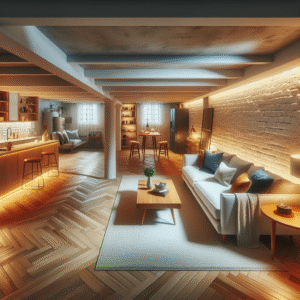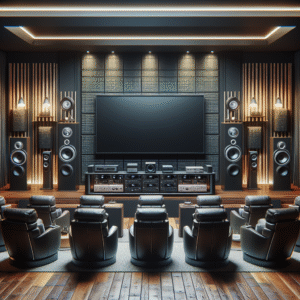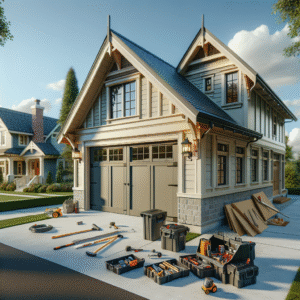Are you dreaming of creating a cinematic experience right in the comfort of your own home? Whether it’s for family movie nights or an immersive gaming session, having a home theater system can transform your entertainment space into a personal multiplex. This guide will walk you through everything from understanding the core components of a home theater to choosing the right equipment, and even how to install it. Gear up to bring the magic of the big screen home!
Understanding the Basics of Home Theater Systems
Before diving into the world of home theaters, it’s essential to grasp the basics. A home theater system comprises several key components including a display unit (like a projector or a TV), sound system, and media players, among others. Additionally, the layout of your room plays a pivotal role in the ultimate viewing experience. Understanding space requirements and strategic layout planning are the first steps towards your dream home theater.
How to Choose the Right Equipment for Your Home Theater
Choosing the right equipment is crucial for the perfect home theater setup. The debate between projectors and large screen TVs is a common starting point. Each has its benefits depending on room size, lighting conditions, and personal preference. Similarly, selecting a surround sound system is key to enveloping yourself in high-quality audio that mimics the acoustics of a real movie theater.
Step-by-Step Guide to Installing Your Custom Home Theater
Installation might seem daunting, but with the right guidance, it can be an exciting project. Start with preparing your space, focusing on aspects like soundproofing and optimal lighting to enhance your viewing experience. Following this, the installation of audio and video components will be your next big task. Finally, don’t forget the importance of calibration and testing to ensure everything looks and sounds just as you imagined.
Ready to get started on your home theater? This guide will provide you with detailed insights and practical tips to help you build the ultimate entertainment hub. Let’s bring the big screen home!
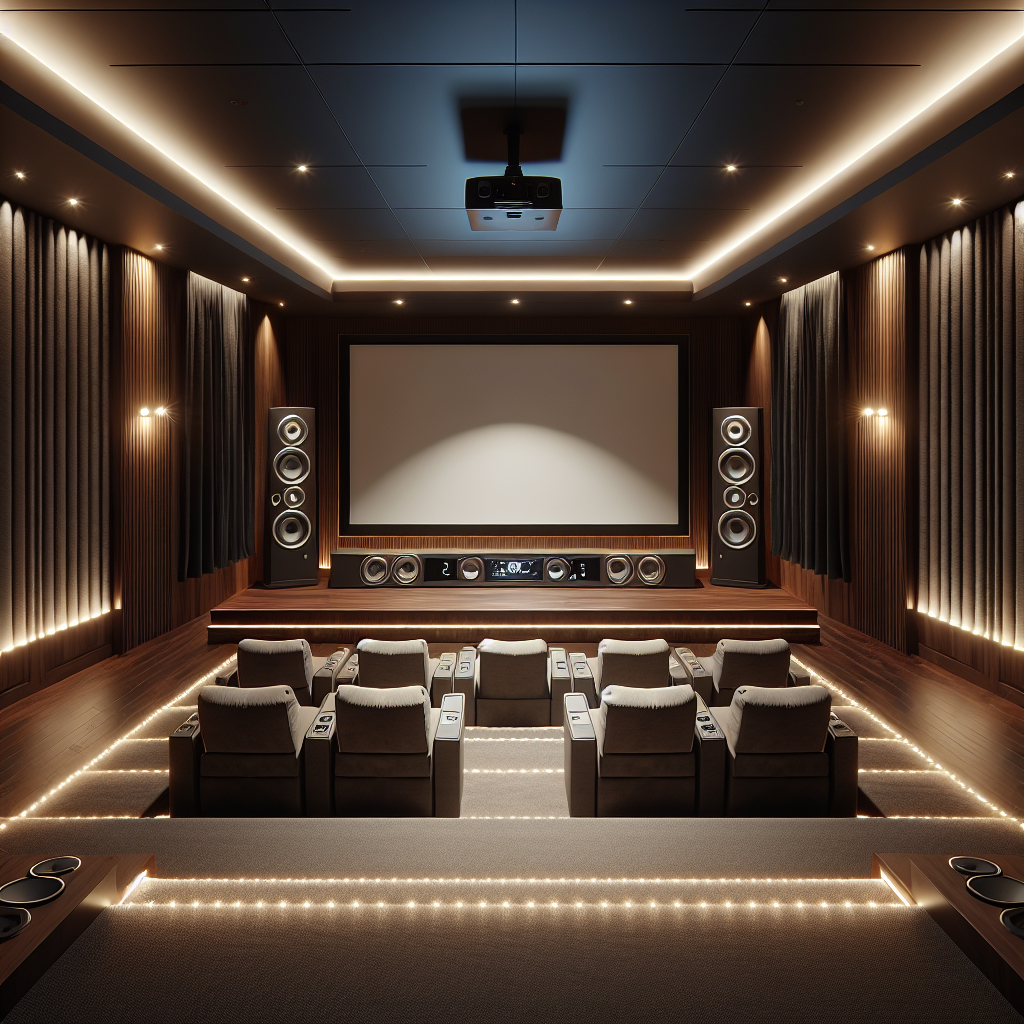
If you’re ready to take your home improvement or construction project to the next level, we can help! Find trusted contractors on BuildNet, whether you’re looking for renovations, new builds, electrical work, plumbing, or anything in between. Our directory connects you with qualified professionals who can make your vision a reality.
Understanding the Basics of Home Theater Systems
So, you’re looking to bring the magic of the movies into your own home? A well-set-up home theater can offer that exhilarating cinema experience without stepping out the door. Whether you’re planning to host movie nights or enjoy immersive gaming sessions, understanding the fundamental components and space requirements is your first step. Let’s dive right into the cinematic world of home theaters!
Key Components of a Home Theater
Every home theater setup revolves around several crucial components that can either make or break your viewing experience. Here’s what you’ll need:
- Display Device: This could be a high-definition TV or a projector and screen combination, depending on your preference and space. It’s the centerpiece of your home theater system.
- Sound System: For that immersive audio experience, a good quality surround sound system is essential. This usually includes a combination of speakers and a subwoofer to get that deep bass sound.
- Media Player: Whether it’s a Blu-Ray player, a streaming device, or even a gaming console, you’ll need something to play or stream your media.
- Seating: Comfortable seating is crucial for those long movie marathons. Recliners or couches with good lumbar support are popular choices.
- Cables and Accessories: Don’t forget the various cables you’ll need to connect all your devices, plus any control systems to simplify managing your home theater.
With these components in mind, you can tailor your choices to fit both your budget and room size, creating a personalized cinema experience at home.
Space Requirements and Layout Planning
The size and layout of your room can significantly impact the effectiveness of your home theater system. Here’s how to make the most of your available space:
Choosing the Right Room
Ideally, a home theater is set up in a rectangular room where the main screen and speaker setup is placed along the shorter wall. This helps in evenly distributing sound and provides a better visual focus. Basements often make excellent home theater spaces due to their low levels of natural light and natural sound dampening properties.
Room Size and Seating Arrangement
The size of the room will determine how many speakers you’ll need and where they should be placed for optimal sound. Generally, a larger room requires more speakers to fill the space with sound adequately. As for seating, ensure there’s enough space between the screen and the first row of seats to prevent strain on your eyes and neck (a good rule of thumb is 1.5 to 2.5 times the diagonal screen size).
Acoustic Considerations
Sound behaves differently depending on room shape, size, and what’s in it. Hard surfaces like windows and concrete walls can cause audio distortions, so consider acoustic treatments such as curtains, carpets, and specialized wall panels to improve sound quality.
Lighting and Ambiance
Ambient lighting plays a crucial role in your home theater room. Soft, dimmable LED lights can create the right mood and won’t interfere with the screen’s visibility. It’s also worth considering blackout curtains or shades to prevent any external light from ruining the picture quality.
By understanding these essential components and considering the specifications of your space, you can set the stage (or should we say screen?) for many enjoyable movie nights. Remember, every home and every room is different, and part of the fun is customizing the space to fit your unique needs and style. So grab your popcorn, dim the lights, and get ready to press play on your new home theater adventure!

How to Choose the Right Equipment for Your Home Theater
So, you’re ready to transform your living space into a personal cinema paradise? Congratulations! Selecting the right equipment for your home theater can be thrilling yet daunting. Whether you’re a movie aficionado or a sports fan wanting to enhance your viewing experience, understanding the pros and cons of projectors versus large screen TVs, and comparing the top surround sound systems, will ensure you make the best choices for your home theater setup.
Projectors vs. Large Screen TVs: What’s Best for You?
When it comes to creating a true cinematic experience in your home, the choice between a projector and a large screen TV is pivotal. Here’s how you can decide which fits best with your home theater dreams:
Projectors
- Size Flexibility: Projectors offer an adjustable screen size. Whether you’re watching a cozy movie for two or hosting a blockbuster night for friends, you can modify the screen dimensions to suit your audience.
- Space-Saving: A projector can be mounted on the ceiling or placed on a shelf, taking up minimal space. This makes it ideal for smaller rooms or multi-purpose spaces.
- Cinema Feel: For those seeking the allure of a movie theater experience at home, projectors can recreate this with large, expansive visuals that cover your entire field of vision.
Large Screen TVs
- Brilliant Resolution: Large screen TVs often boast higher resolutions and better picture quality right out of the box. Perfect for those who value crystal-clear images and vibrant colors.
- Usability: TVs are generally easier to set up compared to projectors. They’re ready to go with minimal installation, and there’s no need to darken the room completely to get the best picture.
- Smart Features: Many modern TVs come equipped with smart capabilities, allowing you to stream your favorite services without the need for additional devices.
In choosing between a projector and a TV, consider your room’s lighting, the available space, and your particular viewing habits. Do you prefer watching during the day or only at night? Is your room able to be darkened easily? Reflecting on these questions will guide your decision.
Surround Sound Systems: Comparing Top Models
No home theater is complete without a sound system that can deliver the immersive audio to match your visual setup. Here’s a comparison of some top surround sound system models to help you find the perfect match for your cinematic sanctuary:
Dolby Atmos Systems
For those who crave three-dimensional sound, systems equipped with Dolby Atmos are top-tier. They provide a lush soundscape by adding overhead sound effects to create a fully immersive audio experience. Brands like Sony and Samsung offer premium models that cater to audiophiles.
5.1 Surround Sound
Perhaps the most common setup, the 5.1 surround sound system, includes five speakers and one subwoofer. This configuration covers most of the bases for a robust home theater sound. Companies like Yamaha and Bose provide systems that balance cost and performance beautifully.
7.1 Surround Sound Systems
For larger rooms or those seeking an even more enveloping sound, the 7.1 systems add two additional rear speakers to the traditional 5.1 array, enhancing the audio depth and providing a more detailed directionality of sound.
When selecting a surround sound system, consider the size of your room and the primary type of content you’ll be watching. Movies and games often benefit from more complex systems like a 7.1, whereas standard TV shows might not make full use of such advanced setups.
In conclusion, whether you lean towards a projector or a large screen TV, paired with the right surround sound system, you’re all set for many memorable home theater nights. Remember to choose based on your personal needs, the nature of your room, and your favorite viewing activities. Happy watching!
Step-by-Step Guide to Installing Your Custom Home Theater
Welcome to the exciting journey of installing your custom home theater! Whether you’re a film buff, a sports fan, or a gaming enthusiast, having a dedicated space to enjoy your passion can significantly enhance your experience. Let’s dive into how you can transform your room into a spectacular home theater, step-by-step.
Preparing Your Space: Soundproofing and Lighting
Before we get into the nuts and bolts of installing audio and video components, it’s essential to prepare your space properly. Soundproofing and lighting play pivotal roles in creating the perfect cinema environment.
Soundproofing
Soundproofing your home theater ensures that you get immersive audio experience while minimizing noise disturbances to other areas of your home. Here are a few tips:
- Use Acoustic Panels: Installing acoustic panels on walls can dramatically reduce sound leakage and improve audio clarity.
- Install Thick Carpets: A thick carpet not only adds to the aesthetic but also absorbs sound, reducing echo.
- Seal Doors and Windows: Use weatherstripping or acoustic seals around the doors and windows to prevent sound escape.
Lighting
Lighting sets the mood and can affect how you perceive the picture quality. Consider these strategies for optimal lighting:
- Dimmable LED Lights: Installing dimmable LED lights gives you control over the brightness, which can be adjusted based on what you’re watching.
- Blackout Curtains: These are perfect for preventing any external light from washing out your screen’s picture.
Installing Audio and Video Components
Now that your room is prepped, it’s time to install the core elements of your home theater — the audio and video components.
Video Installation
Whether you’ve chosen a projector or a large screen TV, placement is crucial:
- TV Wall Mount: If you’re going with a TV, ensure it is mounted at eye level and the viewing distance is approximately three times the screen’s diagonal width.
- Projector Setup: For projectors, mount the projector in a central location on the ceiling and pair it with a high-quality projector screen fixed to a wall.
Audio Setup
Surround sound can turn a standard viewing into an extraordinary one. Here’s how to set it up:
- Speaker Placement: Place the center speaker directly below or above your screen, front speakers to the side of the screen, and surround speakers to the sides of your seating area.
- Subwoofer Location: Subwoofers are less directional, so they can be placed almost anywhere, but corners tend to enhance bass response.
Calibration and Testing for Optimal Viewing Experience
Last but certainly not least, calibrating your setup ensures you get the best audiovisual performance. This might sound technical, but it’s a crucial step:
Video Calibration
Adjust the brightness, contrast, and color settings of your TV or projector. Most devices come with presets like ‘Cinema’ or ‘Sports’ but tweaking them to suit your room’s lighting can enhance picture quality.
Audio Testing
Use an SPL (Sound Pressure Level) meter to ensure sound levels from each speaker are balanced. Many modern receivers come equipped with automatic setup systems that can help adjust the audio settings for your specific environment.
Ultimately, installing a home theater is about creating a space where you can relax and enjoy your favorite media to the fullest. Take your time to understand each step, and don’t hesitate to seek professional help if you’re unsure about certain aspects. With a bit of planning and effort, you’ll be all set to press play on a truly cinematic home experience. Happy viewing!
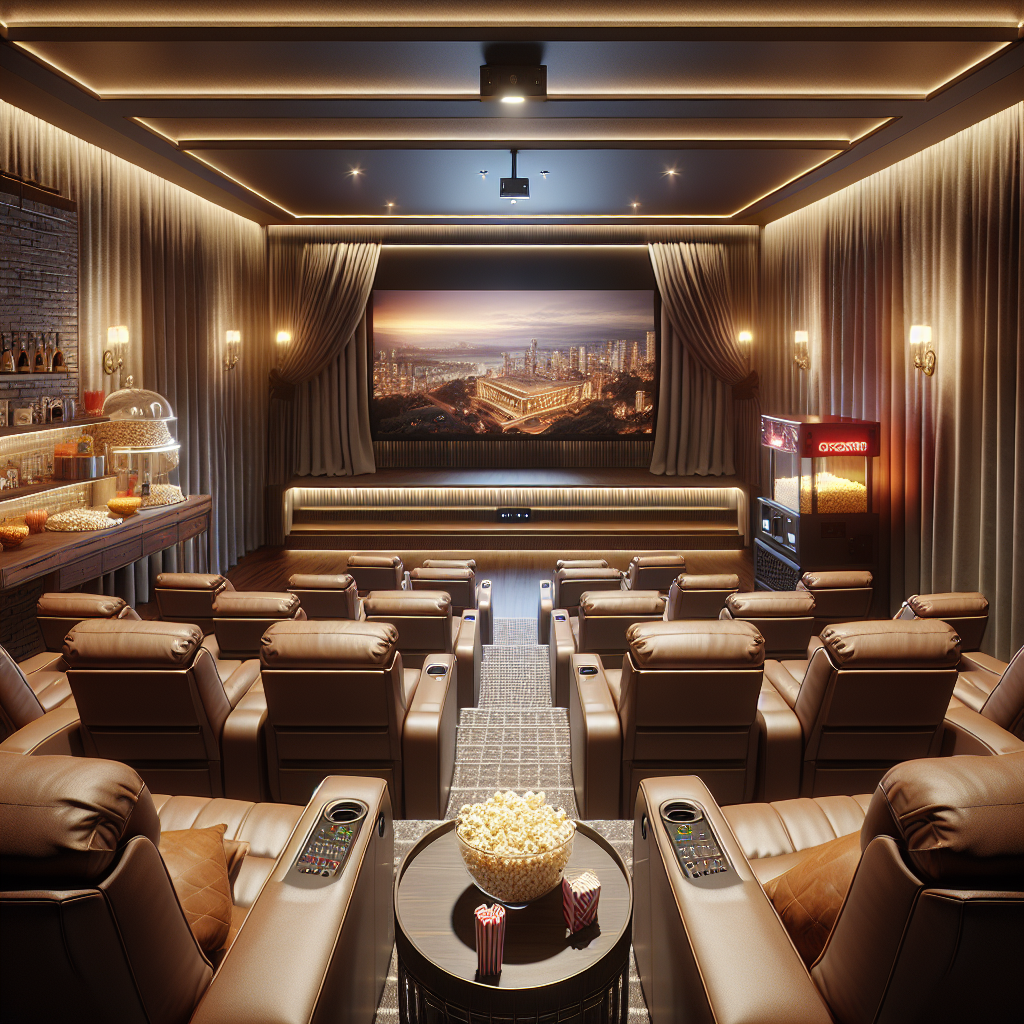
What are the essential components of a home theater system?
A home theater system typically includes a display (such as a large-screen TV or projector), a sound system (like a surround sound or soundbar), media playback devices (DVD/Blu-ray player or streaming device), and comfortable seating. Optimal layout and acoustic treatment can also play a significant role in enhancing the viewing experience.
How do I determine the best layout for my home theater room?
Consider the size and shape of your room, the position of your seating, and the location of speakers for optimal sound distribution. The central viewing area should have a clear line of sight to the screen with no obstructions. For the best audio experience, place speakers at strategic points around the room in accordance with the surround sound format you choose.
Should I choose a projector or a large-screen TV for my home theater?
The choice between a projector and a large-screen TV often depends on your room size, budget, and viewing preferences. Projectors are ideal for a larger, cinema-like experience in a controlled lighting environment. Large-screen TVs, however, are more suitable for brighter rooms and offer higher resolution and ease of setup.
What are the top surround sound systems currently on the market?
Some of the leading surround sound systems include options from brands like Bose, Sonos, and Yamaha. Each brand offers unique features tailored to different budgets and room sizes. Researching and comparing these models based on their sound quality, connectivity options, and compatibility with other devices is beneficial.
What steps should I follow for effective soundproofing in my home theater?
Start by sealing gaps in doors and windows and consider adding acoustic panels or foam to walls to absorb sound. Installing thick carpets and curtains can also help to minimize sound reflections and external noise, creating a more immersive listening environment.
How do I install the audio and video components of my home theater?
Begin by positioning your screen or projector and speakers according to your layout plan. Ensure all components are securely mounted and connected with appropriate cables. Hide cables where possible to keep the area tidy and prevent tripping hazards. Refer to manufacturer guidelines for specifics on settings and configurations.
What is involved in the calibration and testing of a home theater system?
Calibration involves adjusting the video and audio settings to suit the specific acoustics and lighting of your room. Use calibration tools and built-in setup menus to fine-tune brightness, contrast, sound levels, and speaker output. Testing with different types of media can help you ensure that both visuals and audio perform well across various formats and genres.
Conclusion
Building the perfect home theater is an exciting project that combines technology with comfort to create a personal entertainment space. Whether you’re deciding between a projector or a TV, choosing the best surround sound system, or installing and calibrating your equipment, each step is crucial to achieving the best possible outcome. Remember, proper planning and quality equipment are the keys to an immersive viewing and listening experience.
If setting up your home theater seems daunting or you require professional expertise, don’t hesitate to reach out to the skilled contractors at BuildNet. They can offer tailored advice, handle complex installations, and even help with room modifications to ensure your home theater dreams become a reality. Visit the BuildNet website today to get a free quote and start planning your ultimate home theater experience!

